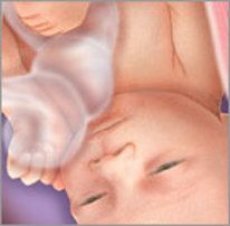Medical expert of the article
New publications
Pregnancy: 35 weeks
Last reviewed: 04.07.2025

All iLive content is medically reviewed or fact checked to ensure as much factual accuracy as possible.
We have strict sourcing guidelines and only link to reputable media sites, academic research institutions and, whenever possible, medically peer reviewed studies. Note that the numbers in parentheses ([1], [2], etc.) are clickable links to these studies.
If you feel that any of our content is inaccurate, out-of-date, or otherwise questionable, please select it and press Ctrl + Enter.

How the child grows:
Your baby is now 46 cm tall and weighs 2.7 kg. Since there is very little space in the womb, he will no longer perform complex acrobatic movements, but the number of movements should not change. His kidneys are now fully developed, and his liver can excrete waste products. Most of his basic physical development has already occurred, now the main focus is on weight gain.
Important: Each baby's development is unique. Our information is designed to give you a general idea of fetal development.
Changes in the expectant mother
Your uterus has reached the level of your chest, and most of it is taken up by your baby, not amniotic fluid. The enlarged uterus puts pressure on your other organs, which is why you have to urinate frequently and experience heartburn and other gastrointestinal problems. If you don’t have any of these conditions, you’re a lucky woman! From now on, your medical appointments will be repeated every week. Before week 37, your doctor will take a vaginal and rectal swab to check for group B streptococcus bacteria. These bacteria are usually harmless to adults, but if you pass them to your baby during labor, they can develop serious complications such as pneumonia, meningitis, or a blood infection. Since these bacteria are found in 10 to 30 percent of pregnant women, screening is essential. If you are found to have the bacteria, you will be given intravenous antibiotics during labor, which reduces the risk of your baby developing an infection.
This is also a good time to create a birth plan. Using our birth plan, you can focus on specifics: who will be present during the birth, pain management techniques, and wishes for where the baby will be after birth. This will give you a point of reference and wishes to discuss with your doctor. Birth is an unpredictable process that does not always go as planned, so discuss your preferences with your doctor ahead of time.
3 Questions about... maternity hospital
- How to prepare for a trip to the maternity hospital?
Before you head to the hospital, you and your partner should find out in advance: where the nearest car park is, when you need to arrive at the hospital, and when you can leave. Most hospitals give presentations and organize familiarization tours for potential clients, so don't miss your chance.
- What happens in the maternity hospital?
Most likely, your doctor has already told you about the necessary actions and given you clear instructions. If for some reason you do not know who to contact at the maternity hospital, go to the clinic reception and a nurse will take you to the delivery room and also inform the midwife of your arrival. The nurse will take a urine sample and help you change clothes, after which she will check your vital signs and ask about the frequency of contractions, whether your water has broken, and whether you have had vaginal bleeding. She will also check the baby's activity, find out when you last ate and how tolerable the pain is.
Your doctor will check the frequency and duration of your contractions, as well as your baby's heartbeat, and then perform an abdominal and vaginal examination. If it turns out that this is a false alarm and labor has not yet started, or is very early, you will probably be sent home.
- The process of childbirth?
The obstetrician will ask you if you have a written birth plan and what your preferences are if you don’t have one. Then, if necessary, they will take a blood test, administer intravenous antibiotics, or spinal or epidural anesthesia. The nurse will also help you get your bearings by showing you what is in the waiting room and where. Don’t be shy about asking for what you need: a rocking chair, ice, or an extra blanket. If a CTG (recording of the fetal heart rate and uterine tone) is performed during labor, the nurse will explain how the cardiotocography works.
This week's activity: Prepare food for you and your partner for the first few weeks after baby is born. Make double portions and freeze half – you and your partner will be too exhausted to cook for the first two weeks after baby is born.
 [ 1 ]
[ 1 ]

